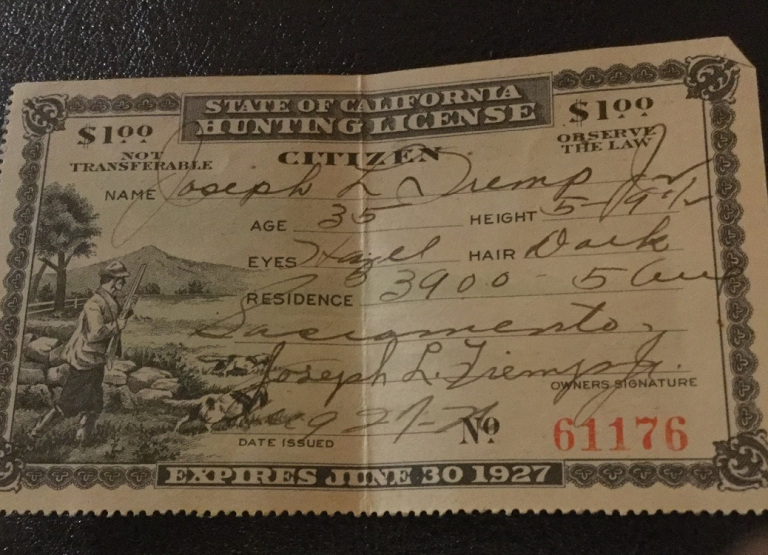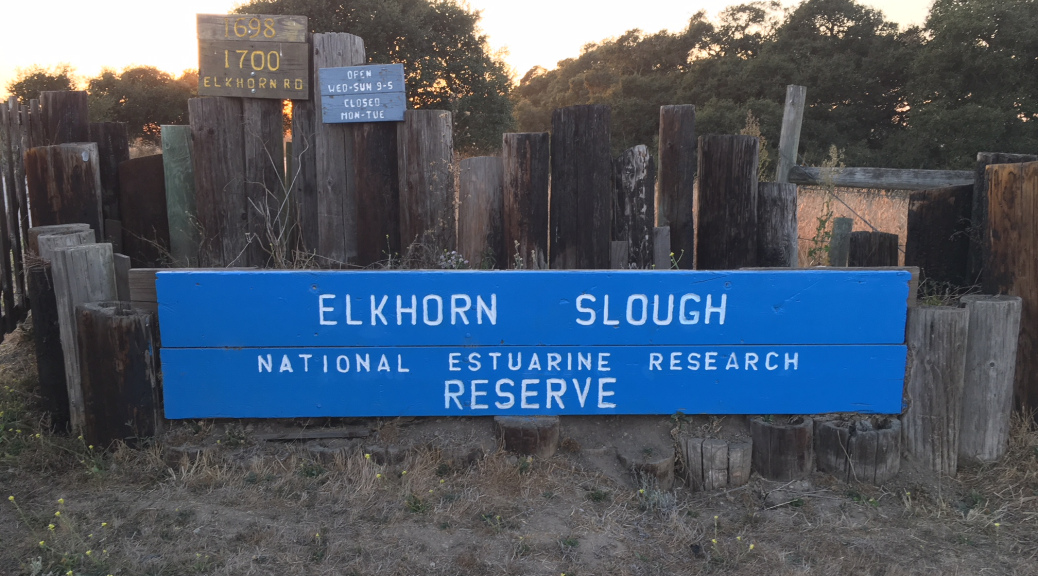Fish Report for 10-13-2018
“Antique” Fishing and Hunting Licenses

by CDFW
10-13-2018
Website
Question: My grandfather was born in 1890 and was a resident of Sacramento. Recently I was going through some documents that were given to me years ago upon his passing, and I found his 1927 fishing and hunting licenses. The cost was $1 each. I thought these were really cool and wonder what you might be able to tell me about them. (Gary)
Answer: Congratulations on owning a piece of California history! The California Legislature began requiring hunting licenses in 1907 as a way to provide additional funding for enforcement of the state’s game laws. Sport fishing licenses became a requirement in 1914.
For the first two years, hunting licenses were issued in the form of metal tags stamped with a serial number and expiration date. In 1909, the state transitioned to the pictorial hunting license depicting beautiful images of sportsmen and wildlife. Your 1926-1927 license represents the last year that pictorial licenses were issued. Subsequent licenses were considered “semi-pictorial” because they featured elaborate borders and fonts, but no illustrations other than the official seal of the California Department of Fish and Game (as we were then called). Pictorial fishing licenses were produced between 1914 and 1926.
License collector Ira W. Cotton published a book in 2007 entitled California Pictorial Hunting and Fishing Licenses: Handbook and Valuation Guide (PaperQuest Press, Omaha, Nebraska). According to Cotton, “California was the first to issue pictorial wildlife licenses and without doubt has issued the most beautiful licenses of any state.”
Cotton’s book includes an exhaustive list of prices for hunting and fishing licenses sold at auction. The prices vary dramatically depending upon the condition of the license and the amount of bidding competition. Three 1927 hunting licenses are listed, with sale prices of $9, $35 and $72, respectively. Six 1927 fishing licenses are listed, with sale prices ranging from $6 to $29.
What Can I Take from the Shoreline?
Question: When my family visited the beach, we found some edible seaweed, small crabs, small clams, turban (top) shells and mussels. These were located about 10-20 yards from the edge of the sea. What are the regulations for catch or take? Would I need a license? (Boik)
Answer: The daily bag limit on all marine aquatic plants for which take is authorized for non-commercial use is 10 pounds, wet weight in the aggregate. Except as provided in California Code of Regulations Title 14, sections 30.00 and 30.10, there is no closed season, closed hours or minimum size limit for any species of marine aquatic plant. Marine aquatic plants may not be cut or harvested in state marine reserves, and regulations within state marine conservation areas and state marine parks may prohibit cutting or harvesting of marine aquatic plants (CCR Title 14, section 632(b)). Eel grass (Zostera), surf grass (Phyllospadix) or sea palm (Postelsia) may not be cut or disturbed (CCR Title 14, section 30.10). You do not need a fishing license to take marine plants, including kelp, for non-commercial use.
Tidal invertebrates may not be taken in any tidepool or other areas between the high tide mark and 1,000 feet seaward and lateral to the low-tide mark, with the exceptions of red abalone, limpets, moon snails, turban snails, chiones, clams, cockles, mussels, rock scallops, native oysters, octopuses, squid, crabs, lobsters, shrimp, sand dollars, sea urchins and worms (CCR Title 14, section 29.05 (b)). Take of all invertebrates is prohibited within state marine reserves. Take of certain invertebrates may be prohibited within state marine parks and state marine conservation areas as per sub-section CCR Title 14, section 632(b). All other rules and regulations apply to the species listed above which include but are not limited to bag/possession limits, seasons, gear restrictions, possession of a measuring device (CCR Title 14, section 29.05(c)), and special closures. A sport fishing license is required to take tidal invertebrates.
When is a Good Time to Collect Shells?
Question: This is probably a strange question, but I am wondering if you keep records of when it is a good time to collect shells, and what beaches are best to collect from. I know that different times of the year there are more than other times, such as up in Mendocino. (Sharon)
Answer: CDFW does not collect data pertaining to the collection of seashells. In general, however, the best time to collect shells is during a low or minus tide, as the lower than average tide heights allow collectors to locate shells usually covered by water, sand and high surf. Tide books or tidal apps may provide information on the tide predictions for your area. Each tidal area contains a variety of shells based on habitat structure. It is unlawful to injure, damage, take or possess any living, geological or cultural marine resource within state marine reserves. Take or possession of any living, geological or cultural marine resource may be prohibited within state marine parks and state marine conservation areas as per sub-section CCR Title 15, section 632(b). Please remember that when you are hunting for shells, you should never turn your back on the ocean, as ocean conditions are unpredictable and can quickly turn dangerous.
More Reports
Upper Klamath River Quota Met
Klamath River - Upper - CA
10-10-2018
Based upon California Department of Fish and Wildlife (CDFW) projections of the recreational fall Chinook salmon catch on the Klamath...... Read More
California Department of Fish & Wildlife Reports
for Sunday, October 7th, 2018
: SHARE Program to Offer Wild Pig, Bear, Turkey, Quail and Dove Hunts this Fall
: CDFW’s Elkhorn Slough Designated ‘Wetland of International Importance'

Website Hosting and Design provided by TECK.net